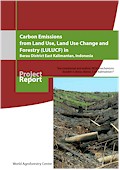| Report |
 |
|
| Title | Carbon Emissions from Land Use, Land Use Change and Forestry (LULUCF) in Berau District East Kalimantan, Indonesia | | Author | Andree Ekadinata, Arif Rahmanulloh, Fadjar Pambudhi, Ibe Ibrahim, Meine van Noordwijk, Muhammad Sofiyuddin, Mustofa Agung Sardjono, Subekti Rahayu, Sonya Dewi, Suseno Budidarsono and Zuraidah Said | | Year | 2010 | | Institution | World Agroforestry Centre - ICRAF, SEA Regional Office | | City | Bogor, Indonesia | | Report Number | Project Report | | Number of Pages | 48 | | Call Number | RP0269-11 |
|
| Abstract: |
| The overall emission and proportion of emission that is associated with negative, low and high opportunity cost is presented in Figure 2. Conversions to oil palm is shown to be in the high end both in the opportunity cost curve of emissions, due to its NPV which by far is highest compared to any other land use systems. The proportion of emission from conversion to oil palm increases over time. Logging is the single activity that causes the highest proportion of emissions with lower benefit than oil palm conversion per unit C emitted, especially if the conversion is from logged over forest. From ICRAF study on carbon footprint from oil palm plantation development, when the land cover of Cstock lower than 40 t/ha, e.g., grassland, shrubs, is converted to oil palm, there is no C-debt in the long run (assuming 25 years rotation). It is interesting to note here is the large portion of emission that is associated with establishment of forest plantation, which seems to be increasing in the more recent period. The forest plantation to supply raw materials to pulp and paper industry has been established in logged-over forest and undisturbed forests. |
|
|
Download file(s): Click icon to download/open file.
|
| |
File Size |
Description |

|
1,604 KB |
Softcopy-1 |

|
2,081 KB |
Softcopy-2 |

|
793 KB |
Softcopy-3 |
|
|
|
| Viewed in 3771 times. Downloaded in 1693 times. |